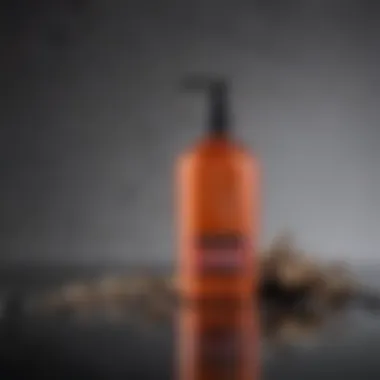Best Shampoos for Post-Chemotherapy Hair Care


Intro
Chemotherapy can lead to significant hair changes, from loss to texture shifts. The hair care choices made during this time are crucial in promoting healthy regrowth. Understanding how to select the right shampoo becomes essential for many. This guide will help women of all ages to navigate this complicated landscape of hair care post-chemotherapy.
The focus here is on discovering the best shampoos for recovery. Readers should anticipate discussions on the unique needs of post-chemo hair and the ingredients that can aid in the recovery process. In this guide, we will explore gentler alternatives that can help rejuvenate hair without aggravating sensitive scalps. By comprehending the science of hair health, individuals can choose products that fortify—rather than harm—their hair during the fragile recovery phase.
"Choosing the right shampoo is not merely about fragrance or promotion; it is about understanding the chemistry behind hair care and how it applies to those recovering from chemotherapy."
In this article, we will delve into key trends in hair care formulations, essential tips tailor-made for sensitive and recovering hair types, and recommendations for sustainable practices. The aim is to empower individuals with knowledge and actionable advice for nurturing their hair back to health.
Understanding Chemotherapy and its Effects on Hair
Understanding the effects of chemotherapy on hair is crucial for those who have undergone treatment. Chemotherapy works by targeting rapidly dividing cells, which unfortunately includes healthy hair follicles. This leads to significant hair loss and other scalp-related issues. By comprehending the biological mechanisms behind these changes, individuals can make informed choices to support their hair's recovery post-treatment.
The Biological Impact of Chemotherapy
Chemotherapy agents are designed to attack cancer cells. However, they do not discriminate and can also affect normal cells, especially those in areas like hair follicles. Hair loss occurs because the drugs disrupt the hair growth cycle. Each hair strand goes through a growth phase, a resting phase, and eventually falls out. Chemotherapy can cause an accelerated transition into the shedding phase, culminating in hair thinning or complete loss.
Hormonal changes can also happen during treatment. These alterations may affect hair growth and texture. It might come back finer or have a different color after recovery. Understanding these biological impacts helps in setting realistic expectations for hair regrowth and health.
Common Hair Loss Patterns During Treatment
During chemotherapy, individuals may experience various patterns of hair loss. Some might notice diffuse thinning, while others may experience patches of hair loss, depending on the type of chemotherapy regime. Notably, some may lose hair everywhere, including eyebrows and eyelashes. This could lead to feelings of vulnerability and affect self-esteem. Recognizing these patterns normalizes the experience, forging a path for empathetic support among peers and health professionals.
Restoration Phases: What to Expect After Treatment
After chemotherapy, the journey of hair restoration begins. Initially, regrowth may appear as fine, soft fuzz, often referred to as "peach fuzz." This stage is a normal part of the recovery process and can take several weeks to months.
Over time, many individuals notice that their hair begins to thicken and become more robust. Although it might not be identical to what it was prior to treatment, it often develops new characteristics, such as altered texture or color.
It is essential to understand that recovery is gradual. Patience and proper hair care practices aid in achieving the best results. Supportive products, like specially formulated shampoos, can significantly bolster the healing process, providing nourishment and care.
"The journey of hair recovery is as unique as the individual navigating it. Understanding the phases enhances the approach towards targeted care."
By grasping these concepts, individuals can better prepare for the changes in their hair and focus on recovery strategies that enhance overall hair health.
Criteria for Selecting Post-Chemotherapy Shampoos
Choosing the right shampoo after chemotherapy is crucial. The right shampoo can significantly impact the recovery and reintegration of hair. Chemotherapy often causes changes to hair texture, thickness, and overall health. This understanding is essential when selecting products that will nourish and rejuvenate the scalp and hair follicles.
Understanding Your Hair Type Post-Treatment
After treatment, hair may come back softer, thinner, or even curlier. Assessing your hair type is the first step in this journey. It may require some observation to see how your hair behaves as it grows back. Keep track of the texture and moisture levels. For example, a dry scalp may need more hydrating formulas, while sensitive skin might benefit from gentle, non-irritating options. Remember, this stage is temporary, and adjustments may be necessary as hair continues to change.


Key Ingredients to Promote Scalp Health
Look for shampoos containing beneficial ingredients. Natural oils like argan or jojoba can help lock in moisture. Additionally, ingredients such as aloe vera and chamomile provide soothing properties. These can help alleviate irritation and support the healing process. Nourishing your scalp is vital, as a healthy scalp creates the environment conducive to hair growth.
- Aloe Vera: Hydrating and soothing effect on the scalp.
- Jojoba Oil: Mimics natural scalp oils, promoting moisture balance.
- Chamomile Extract: Calming properties that reduce irritation.
The Importance of pH Balance
Maintaining pH balance is key to scalp health. Hair and scalp typically have a pH of around 4.5 to 5.5. Shampoos that are too alkaline can strip oils from the scalp, causing dryness and irritation. Look for products specifically labeled as pH-balanced to preserve the scalp’s natural barrier. This balance keeps the hair cuticles smooth and reduces frizz, which is beneficial in the recovery phase.
Avoiding Harsh Chemicals and Additives
Selecting a shampoo free from sulfates, parabens, and artificial fragrances is essential. These ingredients can be damaging to already sensitive scalps, leading to more irritation or even allergic reactions. Aim for formulations that emphasize natural ingredients. Always read labels to ensure that the product aligns with your scalp's needs. Choosing gentler, safer options can significantly improve your shampoo experience, allowing for a smoother recovery process.
Recommended Shampoo Types for Post-Chemotherapy Care
Selecting the right shampoo post-chemotherapy is crucial for restoring hair health. Chemotherapy can compromise the integrity of hair, making it important to use products designed specifically for this delicate phase. The aim is to choose shampoos that can nurture the scalp, promote hydration, and encourage healthy hair regrowth.
With a variety of options available, understanding the different categories can help in making informed choices. The four main types of shampoos suitable for post-chemo care include hydrating shampoos, gentle cleansers, shampoos enriched with natural extracts and oils, and protein-based shampoos. Each type serves specific functions that cater to the unique needs of post-treatment hair. Below, we will explore these categories in detail.
Hydrating Shampoos for Dry Scalps
Hydrating shampoos are essential for combating dryness that often occurs after chemotherapy. These products aim to restore moisture and suppleness, which can be lost due to the treatment process. Ingredients such as aloe vera, glycerin, and hyaluronic acid are commonly found in hydrating shampoos. They help to attract and retain moisture, soothing the scalp and preventing flaking.
Key benefits of hydrating shampoos include:
- Reduced itching and irritation due to improved hydration.
- Enhanced elasticity in hair strands, leading to softer, more manageable hair.
- Support for scalp health, which is necessary for future hair growth.
Gentle Cleansers for Sensitive Skin
Post-chemotherapy, the scalp can become particularly sensitive. Gentle cleansers are formulated to be non-irritating and free from harsh sulfates, which can strip the scalp of natural oils. These shampoos are designed to cleanse without causing inflammation or discomfort.
Important aspects of gentle cleansers:
- Formulated with safe, mild ingredients that minimize irritation.
- Maintain the scalp’s natural barrier, protecting against external aggressors.
- Often include soothing botanical extracts, such as chamomile or calendula, to calm the skin.
Shampoos with Natural Extracts and Oils
Natural extracts and essential oils can provide significant benefits for scalp and hair health. These shampoos often contain ingredients like tea tree oil, argan oil, and jojoba oil, which nourish the hair and scalp. They can promote healing and are known for their anti-inflammatory and antioxidant properties.
Benefits of shampoos with natural extracts:
- Help reduce inflammation and promote a healthy scalp environment.
- Nourish hair follicles, which is beneficial for hair regrowth.
- Provide a natural fragrance without synthetic chemicals.
Protein-Based Shampoos for Strengthening Hair


After chemotherapy, hair strands can become weak and prone to breakage. Protein-based shampoos contain hydrolyzed proteins that penetrate the hair shaft, helping to restore strength and resilience. Ingredients like keratin and silk proteins are often included to reinforce the hair structure.
Main advantages of protein-based shampoos:
- Reinforces hair, minimizing breakage and enhancing overall strength.
- Supports the repair of damaged hair cuticles, leading to a smoother texture.
- Improves overall hair health, making it more resilient to environmental stressors.
Top Shampoo Brands for Post-Chemotherapy Recovery
Selecting the right shampoo post-chemotherapy is crucial for restoring hair health. The right products can significantly impact the recovery process, making it essential to choose those specifically formulated for sensitive, regenerating hair. These brands often prioritize nourishing ingredients and avoid harsh chemicals, which align with the needs of patients recovering from treatment. Factors such as hydration, scalp health, and gentle cleansing properties make certain brands stand out. This section reviews top shampoo brands that cater to these needs specifically, helping readers make informed decisions on hair care post-therapy.
Brand A: Formulation and Benefits
Brand A focuses on natural ingredients like aloe vera and chamomile. These components provide hydration and soothe irritated scalps. The formulation is free from sulfates and parabens, making it appropriate for sensitive skin. Customers have reported noticeable hydration and improved hair texture after use. This brand’s shampoos also help in balancing the scalp’s pH levels, essential for hair recovery. Such benefits cater well to those recovering from chemotherapy, as they address common issues like dryness and sensitivity.
Brand B: Unique Selling Points
Brand B sets itself apart with its commitment to organic formulations. This brand uses botanically derived extracts combined with essential oils. These elements not only cleanse but also nourish the scalp and hair. Their unique selling point includes fragrance-free options, which is a plus for those who may experience scent sensitivities post-treatment. Users praise the mildness of the products and their ability to restore shine and health to dull hair. The emphasis on environmental sustainability also resonates with many consumers seeking ethical options for their hair care.
Brand C: Customer Feedback and Efficacy
Customer feedback on Brand C reveals a high level of satisfaction among users. Many state that their hair feels stronger and softer after regular use. The brand is known for its targeted formulas, specifically developed for hair loss and regrowth. Reviews often highlight improvements in overall scalp health and reduced itchiness. Peer recommendations frequently mention its effectiveness against hair thinning, an important aspect for those recovering from chemotherapy. This positive reception shows the brand’s solid reputation in the market.
Brand D: Special Features for Sensitive Scalp
Brand D specializes in products for individuals with highly sensitive scalps. They incorporate calming agents like calendula and tea tree oil in their formulations. These ingredients not only help alleviate irritation but also provide an antioxidant-rich environment for hair regrowth. Furthermore, their shampoos are dermatologically tested, ensuring safety and efficacy. Customers appreciate the lightweight feel of the formula, which cleanses effectively without weighing hair down. Such features are significantly beneficial for those who had a compromised scalp due to treatment, making this brand a suitable choice.
Complementing Your Shampoo with Additional Care
Complementing the shampoo you select for post-chemotherapy hair care is vital for encouraging overall hair health and recovery. The process of rebuilding hair after chemotherapy is often slow and requires a multifaceted approach. Using a combination of suitable products can help improve the condition of the hair and scalp, ensuring a healthier environment for new growth.
Conditioners Specifically for Chemotherapy Recovery
Conditioners designed for chemotherapy recovery serve a crucial role. They provide additional moisture and nourishment to hair that may be dry and brittle from the effects of treatment. Look for conditioners with ingredients like aloe vera, shea butter, or natural oils like argan oil. These components help hydrate and soften the hair, minimizing breakage and split ends.
Using a rich conditioner after shampooing helps to close the hair cuticle, locking in moisture. Apply it generously, especially to the ends of your hair, and allow it to sit for a few minutes before rinsing.
Scalp Treatments and Their Importance
The scalp often experiences sensitivity after chemotherapy treatment. Using specialized scalp treatments can help soothe irritation and promote healthy skin. Ingredients such as tea tree oil or chamomile can alleviate dryness and itching. These treatments can also enhance blood circulation, which is essential for hair growth.
Make sure to incorporate a scalp treatment into your routine at least once a week. Apply the treatment gently, massaging it into the scalp. This can create a calming effect and support the skin’s recovery.
Nutritional Aspects That Support Hair Growth


Nutrition plays a significant role in hair recovery. A diet rich in vitamins and minerals can enhance the effectiveness of your hair care regimen. Focus on incorporating food high in vitamins A, C, D, and E. Proteins are also important, as hair is primarily made of keratin, and healthy fats can support scalp health.
Consider including these food items in your daily meals:
- Leafy greens like spinach
- Fatty fish such as salmon
- Nuts like almonds
- Eggs for biotin
- Fruits like berries or avocados
Maintaining a Gentle Hair Care Routine
Creating a gentle hair care routine is essential for your recovery process. Avoid heat styling tools to reduce damage, and instead let your hair air dry. Be patient with your hair, and limit washing to 2-3 times a week to retain natural oils. Soft, cotton hair ties can prevent breakage during styling.
Additionally, use a wide-tooth comb to detangle wet hair, which is more susceptible to damage. By treating your hair and scalp with care, you reduce the risk of further issues as they recover.
"The journey of hair recovery post-chemotherapy involves not just products, but a nurturing approach to care."
In summary, complementing your chosen shampoo with appropriate conditioners, scalp treatments, nutritional care, and a gentle routine creates a supportive environment for your hair as it begins to grow back. This holistic approach ensures that you address both the immediate needs of your hair and promote long-term health.
Understanding Potential Side Effects and Reactions
Understanding the side effects and reactions that can occur post-chemotherapy is an important aspect of hair care. Patients frequently experience changes in hair texture, scalp sensitivity, and even allergic reactions to products that were previously tolerated. This information is crucial for making informed choices about hair care products and routines. Being aware of these potential issues allows individuals to manage their expectations and take proactive steps in their recovery.
How to Identify Reactions to Hair Products
It's vital to know how to identify reactions to hair products, especially after chemotherapy. Common signs of a negative reaction include redness, swelling, or rash on the scalp. Patients may also experience excessive itching or an unusual sensation while shampooing or conditioning. Keeping a hair diary can help track any changes in the scalp or hair and pinpoint specific products that may be causing issues. It's best to test new hair products on a small area of the scalp before full application, to see if there is any immediate reaction.
Addressing Itching and Discomfort
Addressing itching and discomfort is essential for comfort and well-being. An irritated scalp can lead to further hair loss, which many post-chemo patients are trying to prevent. Using products specifically formulated for sensitive scalps can help. Look for shampoos that contain soothing agents like aloe vera or chamomile. Additionally, regular scalp massages can promote blood circulation and ease discomfort. If itching persists, consider consulting a healthcare professional to explore potential underlying issues and treatments.
Consulting with Professionals: When to Seek Advice
Consulting with professionals is key to managing hair and scalp health after chemotherapy. If you notice persistent symptoms like chronic itching, redness, or hair loss beyond what was experienced during treatment, it is advisable to consult a dermatologist or oncologist. These professionals can provide tailored advice and may recommend specific treatments or adjustments to your hair care routine that can help in recovery.
It is always better to err on the side of caution. Your scalp and hair health are essential components of recovery.
Ending: Navigating Hair Recovery with Informed Choices
Navigating hair recovery after chemotherapy is a process steeped in both emotional and physical significance. Understanding how to choose the right products and adopting suitable care strategies significantly impacts regrowth and overall scalp health. For many, this journey is not just about looking good but also about regaining a sense of normalcy after a period of intense treatment. Emphasizing informed choices ensures that individuals can address their unique needs effectively.
The gradual return of hair can often induce a range of feelings, including joy and anxiety. By focusing on personalized care, readers can tailor their routines according to their specific situations, whether that involves choosing specific shampoos or integrating additional scalp treatments.
Emphasizing the Importance of Personalized Care
Personalized care is paramount in the post-chemotherapy hair journey. Every individual experiences hair loss and regrowth differently. Thus, customizing a hair care regimen can lead to better outcomes. It is vital to assess the specific scalp conditions and hair quality at this recovery stage, as the right products can become essential allies for healing.
For instance, incorporating shampoos that are hydrating or designed for sensitive skin can make a considerable difference. Likewise, understanding individual reactions to products helps in avoiding irritations that might arise from harsh ingredients. Listening to one’s body is critical. Simple actions like patch testing new products can prevent adverse reactions and allow for adjustments based on personal needs. This approach not only supports hair recovery but also promotes self-empowerment in personal care routines.
Reinforcing the Role of Quality Products
Quality products play a crucial role in supporting hair health post-chemotherapy. Investing in shampoos that include beneficial ingredients such as biotin, essential oils, and natural extracts can lead to improved hair texture and overall health. Not all shampoos are created equal, so scrutinizing labels and product claims is necessary to ensure they align with recovery goals.
Using low-quality products may cause further damage or setbacks during recovery, emphasizing the importance of informed choices. Therefore, products that are free from sulfates, parabens, and other harsh chemicals should be prioritized. It is also worthwhile to consider brands that have garnered positive feedback from users with similar experiences. Engaging with online communities, such as forums on Reddit or groups on Facebook, can provide insights into which products have yielded the best results for others.



